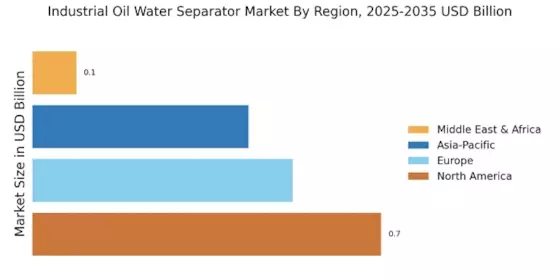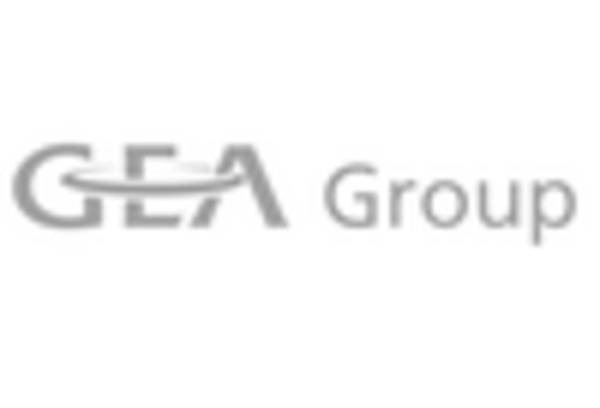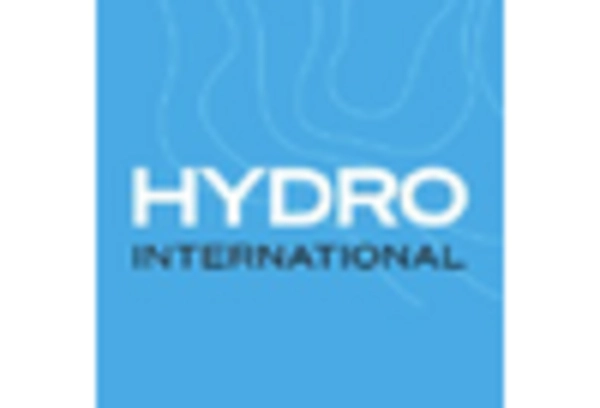Expansion into New Industries
The Industrial Oil Water Separator Market is poised for growth as it expands into new sectors beyond traditional applications. Industries such as food processing, pharmaceuticals, and renewable energy are increasingly recognizing the need for effective oil-water separation solutions. This diversification is driven by the growing awareness of environmental sustainability and the need for efficient waste management practices. For instance, the food processing industry, which generates significant amounts of oily wastewater, is adopting oil-water separators to comply with environmental regulations and improve operational efficiency. Market data suggests that the penetration of oil-water separators in these new industries could lead to a market expansion of approximately 15% over the next five years, indicating a robust opportunity for manufacturers and suppliers.
Increased Focus on Sustainability
The Industrial Oil Water Separator Market is increasingly influenced by a heightened focus on sustainability and environmental stewardship. Companies are recognizing the importance of adopting technologies that not only comply with regulations but also contribute to sustainable practices. The demand for oil-water separators that minimize environmental impact and promote resource recovery is on the rise. This trend is reflected in the growing interest in separators that facilitate the recycling of water and the recovery of valuable resources from wastewater. Market analysis indicates that the sustainability-driven segment of the oil-water separator market could witness a growth rate of around 8% over the next few years, as industries strive to enhance their sustainability profiles and reduce their ecological footprints.
Technological Advancements in Filtration
The Industrial Oil Water Separator Market is experiencing a surge in technological advancements that enhance the efficiency of oil-water separation processes. Innovations such as membrane filtration and advanced coalescing technologies are being integrated into separator designs, leading to improved performance and reduced operational costs. For instance, the introduction of automated monitoring systems allows for real-time assessment of separator efficiency, which can lead to timely maintenance and reduced downtime. As industries increasingly seek to optimize their operations, the demand for advanced separators is likely to rise. This trend is supported by data indicating that the market for advanced filtration technologies is projected to grow at a compound annual growth rate of approximately 6% over the next five years, reflecting the increasing reliance on sophisticated separation solutions.
Rising Industrialization and Urbanization
The Industrial Oil Water Separator Market is benefiting from the rising industrialization and urbanization trends observed in various regions. As urban areas expand and industrial activities increase, the volume of wastewater generated is also on the rise. This escalation necessitates the implementation of effective oil-water separation technologies to manage wastewater efficiently. Industries such as manufacturing, automotive, and construction are particularly contributing to this demand, as they produce significant amounts of oily wastewater. The market is projected to grow in response to these trends, with estimates suggesting a potential increase in demand for oil-water separators by approximately 10% annually. This growth is indicative of the urgent need for effective wastewater management solutions in rapidly developing urban environments.
Regulatory Compliance and Environmental Standards
The Industrial Oil Water Separator Market is significantly influenced by stringent regulatory compliance and environmental standards. Governments and regulatory bodies are imposing stricter guidelines on wastewater treatment and discharge, compelling industries to adopt effective oil-water separation technologies. Compliance with these regulations not only mitigates environmental risks but also enhances corporate responsibility. The market is witnessing a shift towards separators that meet or exceed these standards, which is expected to drive growth. For example, the implementation of the Clean Water Act in various regions has led to increased investments in oil-water separation technologies, with a notable rise in demand for separators that can achieve high removal efficiencies. This regulatory landscape is likely to continue shaping the market, as industries strive to align with evolving environmental policies.


















Leave a Comment